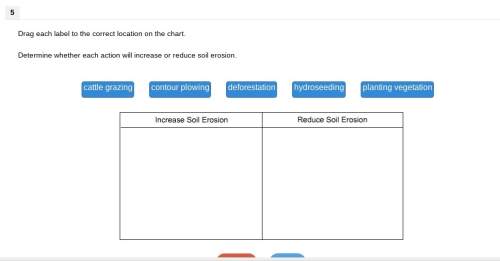
Biology, 12.05.2020 22:57 aesthetickait
Approximately 10% of the energy absorbed by one
trophic level is transferred to the next successive
level. The same number of calories are available at
the primary producer level of each of these food
chains.
Food Chain 1:
phytoplankton → zooplankton → smelt → trout → humans
Food Chain 2: phytoplankton → smelt → humans
How much energy is available to humans in
Food Chain 2 as compared to the energy available
to humans in Food Chain 1 ?
(look at the difference in trophic levels)

Answers: 1


Another question on Biology


Biology, 22.06.2019 01:20
And give a detailed description! scientist observes the boundary between two tectonic plates for a decade and finds that no new volcanoes have formed over the course of her investigation. does this result support the theory of plate tectonics? why or why not?
Answers: 3

Biology, 22.06.2019 03:00
Where does all the water go? according to the environmental protection agency (epa), in a typical wetland environment, 39% of the water is outflow; 46% is seepage; 7% evaporates; and 8% remains as water volume in the ecosystem (reference: united states environmental protection agency case studies report 832-r-93-005). chloride compounds as residuals from residential areas are a problem for wetlands. suppose that in a particular wetland environment the following concentrations (mg/l) of chloride compounds were found: outflow, 60.4; seepage, 73.7; remaining due to evaporation, 26.4; in the water volume, 46.8. (a) compute the weighted average of chlorine compound concentration (mg/l) for this ecological system. (round your answer to one decimal place.) mg/l (b) suppose the epa has established an average chlorine compound concentration target of no more than 58 mg/l. does this wetlands system meet the target standard for chlorine compound concentration? yes. the average chlorine compound concentration (mg/l) is too high. yes. the average chlorine compound concentration (mg/l) is lower than the target. no. the average chlorine compound concentration (mg/l) is lower than the target. no. the average chlorine compound concentration (mg/l) is too high.
Answers: 3

Biology, 22.06.2019 11:00
Astudent poured a solution of bromothymol blue indicator into three test tubes. then he placed an aquatic plant in two of the test tubes, as shown below. he placed a stopper on each test tube and placed them all in the dark for 24 hours. bromothymol blue turns from blue to yellow in the presence of co2
Answers: 2
You know the right answer?
Approximately 10% of the energy absorbed by one
trophic level is transferred to the next succe...
trophic level is transferred to the next succe...
Questions

Mathematics, 22.03.2021 22:20




Mathematics, 22.03.2021 22:20


English, 22.03.2021 22:20





Mathematics, 22.03.2021 22:20

Mathematics, 22.03.2021 22:20

Arts, 22.03.2021 22:20

Biology, 22.03.2021 22:20

Mathematics, 22.03.2021 22:20

Mathematics, 22.03.2021 22:20






